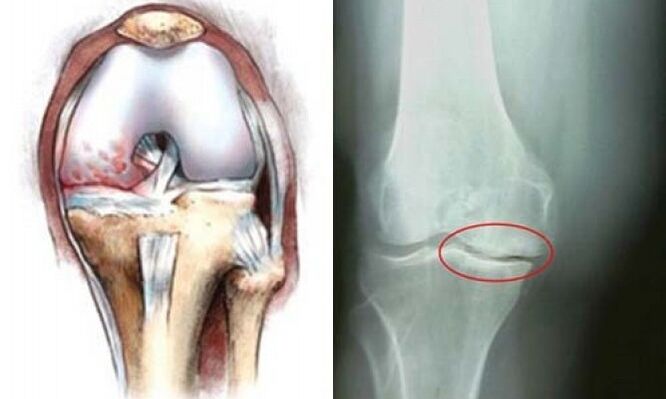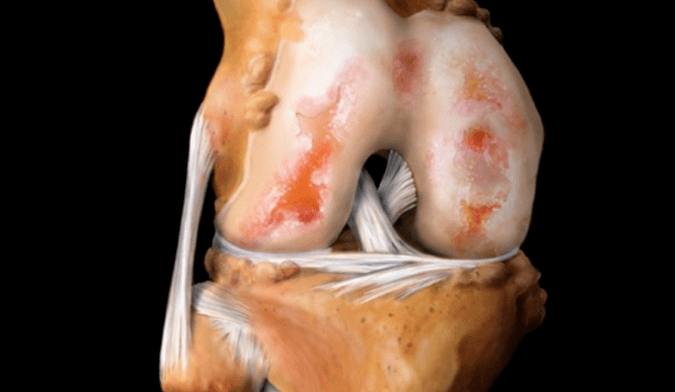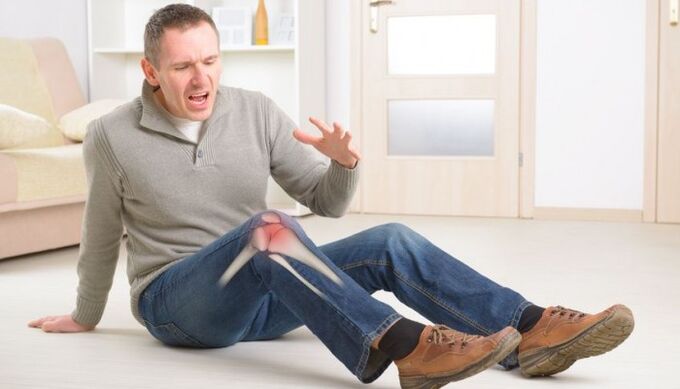Osteoarthritis of the knee joint is very common in the elderly, especially in women. It is also diagnosed in young people. The disease significantly reduces quality of life and, if not treated properly, can lead to disability.
How to recognize arthrosis? What is the cause of this disease? How to cure it?
signs
Arthrosis is a lesion on the hyaline cartilage of the joint. This cartilage is gradually destroyed. First, its structure, the density changes, then it becomes thinner. In severe cases, cartilage may not be completely present.
There is always a fairly strong load on the knee joint, as it is one of the major structural elements of the lower limb. Therefore, signs of knee joint arthrosis can be seen even with minor damage to the joint.
In knee osteoarthritis, symptoms are associated with pain and a gradual loss of knee function.
There are three stages in the development of this disease. Each of them has characteristic symptoms and requires appropriate treatment.
First stage
The first stage in different people can have different durations. In some, changes in the joint progress rapidly, and after a few months the disease passes to the next stage. In others, structural dystrophy of cartilage tissue occurs slowly, many years passing before the appearance of new symptoms.
Signs of first stage knee arthrosis:
- Momentary pain in one or both knees. It usually occurs in the morning, when trying to take the first step, during a long stay in a standing position or while walking up or down stairs. The reason for the significant pain is going down the stairs. There is no pain during rest.
- There are frequent complaints of a slight feeling of stiffness with intense movement in the joint area. But changes in the amplitude of movement were not observed.
- There may be a slight defect due to fluid in the joint cavity, but the bone does not change.
All these symptoms indicate the need to see a doctor. If you start treatment at this stage, there is an opportunity not only to stop the process, but also to begin the recovery process in some parts of the cartilage.
The second level
If you do not seek medical help, the disease will enter the second, next stage. At the same time, old symptoms worsen and additional complaints appear.
Signs that the arthrosis has progressed to the second stage:
- The pain was getting worse. It happens with every movement of the foot. With prolonged walking, lifting heavy objects, the discomfort is especially noticeable. During rest, the pain gradually subsides.
- When moving, there is pain and dryness from the affected joint.
- The range of possible movements begins to decrease, which can cause discomfort. When a person tries to bend the leg at the knee to stop, he either fails, or the bend causes sharp pain.
- On examination, the doctor noted a small change in the shape of the joint. If an x-ray is taken, it will appear that the joint space is too narrow, and a tumor has formed on the edge of the bone.
- A large amount of fluid can accumulate in the joint cavity. This can be detected during diagnostic procedures and during routine examinations.
Often, patients go to the doctor at this stage. In this situation, it is very difficult to achieve a significant recovery, but some positive changes are possible.
The third level

The third stage occurs with severe cartilage destruction and is the most severe. Complaints and examination results of patients with third -degree arthrosis:
- Severe, almost constant pain in the affected joint. When trying to move, it gets stronger. At rest, even in the supine position, the pain does not go away, so there are problems with sleep.
- Movement in the joints is very limited.
- Often the knee "freezes" in a slightly bent state. This affects the patient's foot shape and gait.
- On examination, significant defects in the joints and bones were noticeable.
- X-ray images show the absence of cartilage in many areas of the articular surface, bone sclerosis. The joint space narrows abruptly, a large number of osteophytes are found.
The management of these patients is extremely difficult. You may need surgery.
The reasons
The causes of osteoarthritis of the knee joint are very diverse. Very rarely, a person who has been diagnosed with the disease has only one factor that causes the pathological process. In most cases, changes in cartilage are due to several reasons. The more risk factors, the greater the destruction and loss of function.
Often, arthritis is provoked by such body characteristics and conditions:
- age -related changes in the structure of the musculoskeletal system;
- knee injuries, as well as operations in which damage to the joints can occur;
- too much load on the lower limbs;
- congenital anomalies of the musculoskeletal system or metabolic processes;
- inflammatory processes of various etiologies in the knee area.
Let’s take a closer look at this group of causes.
Age change

Often, knee osteoarthritis develops after 40 years. This is due to the fact that at this age and older, bone structures and cartilage tissues become more fragile, their resistance to stress decreases. Therefore, even long walks can be difficult to tolerate with lower limb joints.
Changes in the musculoskeletal system in women during menopause are particularly pronounced.
During this period, estrogen levels, which previously protected bones from calcium loss, gradually decrease, they become more vulnerable.
Injuries and surgeries
In young people, osteoarthritis can occur as a result of trauma. It may be a broken leg, a dislocated knee, torn ligaments or severe bruising. The longer the time from the moment of injury to proper assistance is given, the higher the risk of complications and occurrence of arthrosis in the near future. Therefore, even with a minor knee injury, you have to go to the hospital.
There is also a high risk of developing arthrosis after surgical intervention in the knee area. Particularly dangerous is the removal of menisci. After such surgery, arthrosis occurs in about 80% of patients.
Traumatic arthrosis usually develops rapidly. Therefore, in such cases, surgical intervention may be required.
Overload
Excessive pressure on the knees is observed in athletes who are professionally involved in sports related to running, jumping, weight lifting. The older a person is, the more carefully he or she should choose options for physical activity in training. Particularly dangerous for the knees are squats, sudden movements and jogging on paved paths.
Too much pressure on the joints of the feet is typical for people who are obese. Then the weight itself creates too much pressure on the cartilage and bones, which leads to their rapid wear and tear.
Congenital pathology

In cases when there is pathology in the musculoskeletal system and metabolic processes, this can also affect the knee joint.
Congenital pathological conditions that mean a high risk of getting arthrosis:
- knee joint anomalies;
- Flat feet;
- disorders of salt metabolism;
- ligament weakness.
If you are aware of such a problem, it is important to pay particular attention to the pain in the knee, not to ignore it, and try to work closely with the doctor.
The phenomenon of inflammation
With arthritis of various etiologies, large amounts of fluid can accumulate in the joints. This leads to the fact that blood circulation is disrupted, nutrients do not reach the bones and cartilage, the structure of cartilage tissue is destroyed. As a result, secondary arthrosis develops.
No less dangerous is the inflammatory process in the vessels of the foot that feeds the knee. When they are clogged with thrombus, the blood supply is dramatically reduced, leading to degenerative processes in the cartilage.
Treatment
Therapy is prescribed taking into account the stage of development of the disease, its causes and the general condition of the body. Principles of arthrosis treatment:
- pain reduction;
- increased supply of cartilage with nutrients;
- stimulation of the recovery process;
- an increase in joint space to reduce pressure on damaged cartilage;
- strengthens and restores muscle function around the joints;
- maximum recovery of motor abilities.
There are several treatment options for knee osteoarthritis. Usually they include a complex of therapeutic procedures.
What can be prescribed to treat this disease:
- Therapeutic training. They are selected by the orthopedic specialist for each patient separately. If you try to make your own complex, engaging in pain, damage to the joints will develop.
- Diet.
- Surgery, prosthetics.
- Drug treatment: non-steroidal anti-inflammatory drugs (tablets or injections), painkillers, condoprotectors, glucocorticoid injections or hyaluronic acid preparations into the joints.
- Additional procedures: hirudotherapy, massage, magnetotherapy, warming with paraffin or ozocerite, electrophoresis, manual therapy and others.
If you experience pain in the joints, you need to visit a doctor. Timely treatment is the key to successful treatment.


















